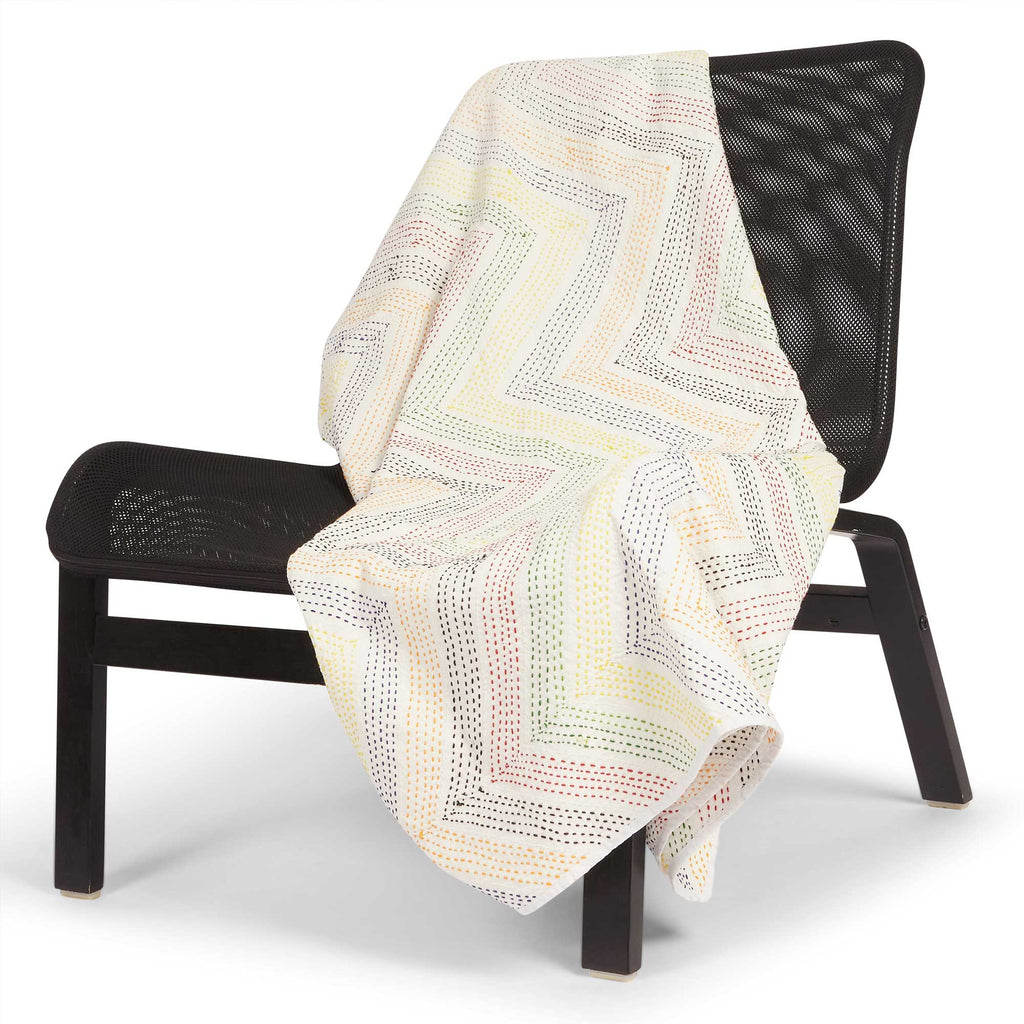Kantha is a centuries-old tradition of stitching patchwork cloth from rags, which evolved from the thrift of rural women in the Bengali region of the sub-continent - today the eastern Indian states of West Bengal and Orissa, and Bangladesh. One of the oldest forms of embroidery originating from India, its origins can be traced back to the pre-Vedic age (prior to 1500 BCE).
"Kantha" refers to both the style of running stitch, as well as the finished cloth.This art form all but disappeared in the early 19th century before being revived in the 1940s. Then it was disrupted again in 1947 at the time of the India / opakistan partition. It wasn’t until 1971 that kantha experienced a re-birth of its own as a highly valued and much desired art-craft form. (thank God for that!)
Kantha, making whole again that which was fragmented or broken.
- Crafts Museum, New Delhi

As with all traditional textiles, kantha was influenced by external factors such as material availability, daily needs, climate, geography, and economic factors. Historically, textile production was one of the most labour-intensive industries, and as such, textiles were highly valued. Thus, the recycling of well used cloth-turned-rags was a natural step in the lifecycle of textiles the world over. Given that this recycling was home-based work, it usually fell to the women of the village to prepare, cut, and stitch the rags - giving old textiles new life.
Around 5-7 fabrics would be layered together, with lighter coloured fabrics on the outside so the stitch and pattern was discernible. The stitch would cover the entire cloth to provide strength.
Women in almost every household in rural villages would be kantha experts and spend whatever quiet time they had available - between looking after the house and children, tending to livestock and during the long days of the monsoon - on stitching the pieces. It could take months or even years to complete one kantha. The stitching could be handed down through generations, with grandmother, mother and daughter working on the same kantha.
Traditionally, kantha was an intimate and utilitarian item, made over a long period of time for use by the family; every family in Bengal had several kanthas for personal use. The majority of kantha was used as light coverlets during the mild Bengali winters and breezy monsoon nights.
Another early use was for swaddling babies. Expectant mothers would spend the last months of their pregnancy stitching the cloth, in the belief that it would bring good fortune to their families and protect the baby from diseases. Other kanthas were specifically created in different sizes for use as satchels or purses, as floor covers for special guests, to store personal items, to cover the Quran or use as prayer mats, or as pillow covers.
If you travel in Bengal today, you will still find modern iterations of the traditional patchwork kantha quilts; airing in the sun on verandas in Kolkata or laid out over paddy fields in the villages to dry.
At Spindle by Sisters we stock 3 types of Kantha quilts, Earth Quilts, Rainbow Quilts and Chaadars. We also have kantha cushions but we will talk about them another day :-)
1. Earth quilts

There are are fashioned from saris that have been discarded and are ready for a new lease of life. We also stock some vintage kanthas that have already experienced many years as a quilt and still have so much more to give.
We work to a set criterion when curating our collections as we look for pieces with minimum patchwork and tight fine kantha stitch so they are sturdy and have many more years to give.
We release these in batches of 5 or 6 pieces and only source more once the first batch has been sold. We do not believe in seasonal homeware and vibrant kantha quilts cannot really fall into any season they are perfect all year around due to their versatility. Click here to discover our one-of-a-kind vintage Earth Collection.
2. Rainbow Quilts

A project we started during the height of Covid in India and our first collection with the ladies in West Bengal that we now work with on a continuous basis. We briefed the artisans to create their own rainbow of hopes during this trying time and in return we got these stunning super soft rainbow throws. (pictured Aasha)
Our first rainbow throw is Ananya, which has a vintage sari as the middle layer and is visible when held up in the light.
3. Kantha Chaadars

These gorgeous pieces are made from 3 layers of handloomed cotton but have no additional padding of any sort in the middle. They are lightweight but also warm. Finished with a fold-over hem these can be used as throws, table cloths, picnic blankets. (pictured Zuri)
